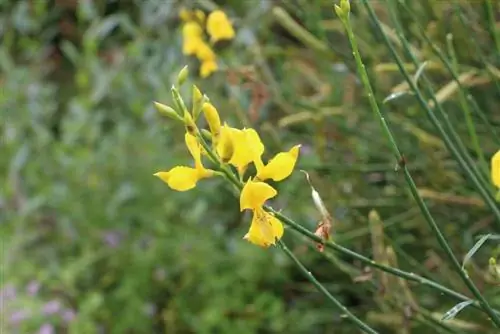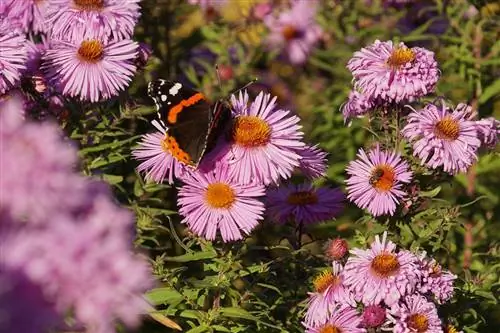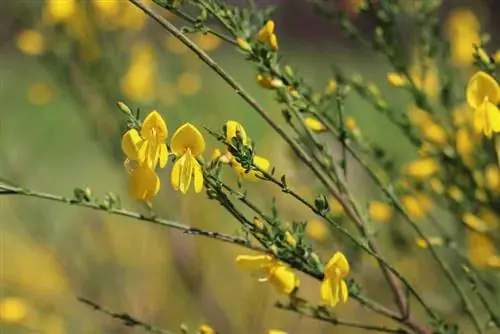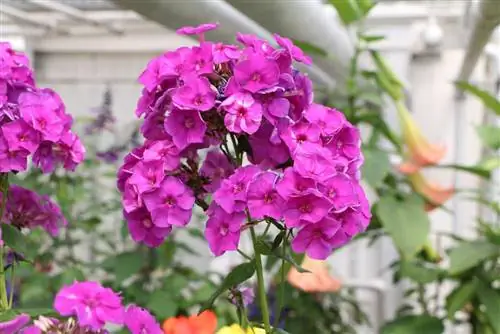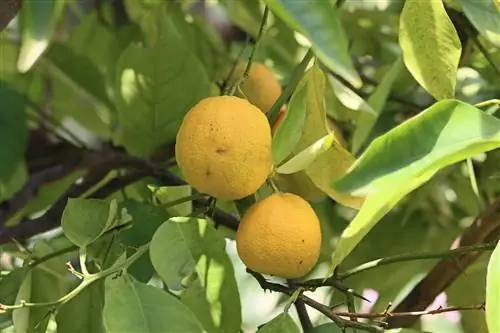- Author admin [email protected].
- Public 2023-12-17 03:39.
- Last modified 2025-01-24 12:45.
To get the most out of your broom, you need the right care and a good cut. A sunny location and poor soil are important for gorse. This means that the gorse can also be planted in places in the garden that are less suitable for other plants. In general, the broom is easy to care for and undemanding and you don't have to fertilize it or water it separately. However, once you have chosen the location for the plant, you should keep it and not transplant it again.
Optimal care of the gorse
Broom prefers a sunny location and rather poor soil. The plant is therefore ideal for garden areas where not many plants normally grow. Otherwise, gorse is relatively easy to care for and does not make any major demands. The shrub does not need to be watered or fertilized. However, the location chosen for the plant should be retained.
Care requirements
- sunny location
- lean soil
- no fertilization required
- no additional watering necessary for rainfall
Grown propagation
If the gorse is to be propagated, this is possible with the help of its seeds. However, the seed capsules must be dry in order to propagate. If this is the case, the seeds can be scattered in the place where the plant should be located. If the gorse is to be propagated as a cutting, then it makes sense to take it in early autumn. It is important that the cutting is at least 15 to 20 cm long when removed.
Overwintering the gorse
Broom is an overall hardy plant that does not require any special protection from frosty temperatures. It should be borne in mind that potted plants should be moved to a protected place in winter. However, a house wall or a protected corner of the garden where the pot is placed is enough for the plant to overwinter successfully.
When it comes to gorse, however, not all gorse is the same when it comes to how the plant overwinteres. The butterflies have many genera that are referred to as gorse. In order to overwinter the broom, you should know which broom is really hardy when purchasing the plant:
- From the Genista genus, gorse is available as a shrub or sub-shrub that can reach a height of 0.5 to two meters and forms a taproot. The yellow-flowering plant can be found as far south as Scandinavia and Poland and is considered to be absolutely hardy, so it does not require any special wintering.
- Another genus is the broom. It grows very quickly in our latitudes and young plants can reach a height of half a meter in their first year of life. This type of broom is native to the Mediterranean region. We often sell it as hardy, but it still freezes right down to the trunk in harsh winters and, contrary to what many sellers claim, does not survive without a good overwintering outdoors.
- The same also applies to so-called white multi-flowered gorse, which can withstand maximum temperatures of minus 12 °C.
- The ivory broom and the fragrant dwarf broom only need a protected location for the winter in order to be hardy.
- A particularly robust plant is the so-called gorse, which has its origins in the Atlantic areas of Europe and is now widespread worldwide. Selected as one of the 100 worst neophytes worldwide, this type of broom shows its perfect handling of unusual locations. This deciduous shrub plant can reach a height of two meters and blooms intensely yellow from April to July. This type of gorse is very hardy and does not require a protected location for overwintering.
- As a deciduous plant, the evergreen avalanche broom or rush broom can reach a height of two to three meters and produce strong yellow and fragrant flowers that last from April to June. The plant, which comes from the Mediterranean region, reacts negatively to both moisture and frost and therefore has to be overwintered as a potted plant in the cellar.
- The thorn broom as a Mediterranean plant will otherwise not survive the winter in Germany without overwintering in the cellar.
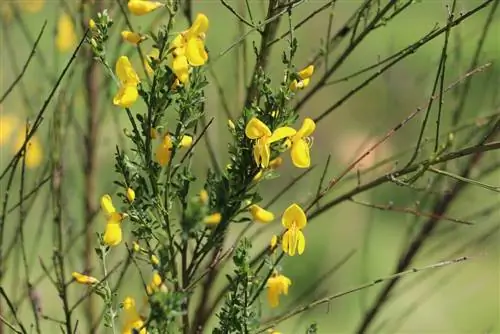
In general, when overwintering gorse, it is important to take into account where the gorse comes from, as this is an important indication of the gorse's wintering needs. Gorse species from Mediterranean regions can only be overwintered if they are kept as potted plants in frost-free rooms over the winter. The environment for the winter-sensitive Mediterranean broom plant should have a temperature of 5 to 10 °C. Moderate watering is required when the top layer of soil is dry. The plant cannot cope with accumulation of moisture during overwintering.
Tip:
If you want to plant certain types of broom outdoors, you should find out about the origin of the plant beforehand.
- Overwintering depends on the origin of the plant
- Mediterranean plants should be overwintered as potted plants indoors at 5 to 10 °C
- Other types of gorse can overwinter in sheltered places outdoors
- really hardy plants do not need any special help during wintering
Cutting the gorse
If you give the gorse its space and never cut the plant back, the plant will quickly take over the territory and take up a large area. As soon as the shoots are on the ground, they form roots and immediately new plants, which quickly spread throughout the area. In this case, many laypeople make the wrong decision and cut back the shoots radically - but the plant cannot tolerate this at all.
Cut the branches very gently and repeat the light pruning again in spring. In this way you can ensure that new growth and flower formation are stimulated. If you discover brown tips in the spring, then the time for pruning may have been unfavorable and too late and frost could hit the freshly cut areas. If it is an older plant, you can approach the matter a little more boldly and cut back to the old wood.
What you should know about broom in brief
The best known in our country is the broom, an upright shrub with broom-like branches. The gorse is particularly popular because of its abundance of flowers between May and June. The flowers are mostly yellow, but plants with orange-brown, red, pink and creamy white flowers are now also available through breeding. The branches also look very nice in a vase. After flowering, the plant should be cut back heavily, otherwise it would become too heavy and eventually tip over. The tree feels most comfortable in full sun, on loamy-sandy, lime- and nutrient-poor soil.
Otherwise, the gorse is very undemanding to care for; it only requires moderate water and hardly any fertilizer. Some species are also frost-resistant, but young plants should always be protected from frost. After flowering, the gorse can be propagated by cuttings, but since the plant has a taproot, it cannot be repotted.
Be careful with children and pets:
All types of broom are slightly poisonous!
Other beautiful trees include: wisteria, clematis and the kiwi plant. There are climbing aids to enable many trees to climb. More about this here: Trellis and trellis.

